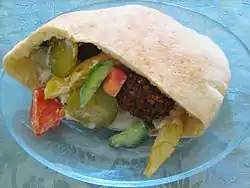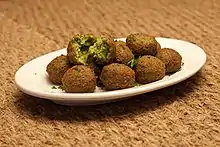Falafel
Falafel (/fəˈlɑːfəl/; Arabic: فلافل, [fæˈlæːfɪl] (![]() listen)) is a deep-fried ball or patty made from ground chickpeas, fava beans, or both. Falafel is a traditional Middle Eastern food, commonly served in a pita, which acts as a pocket, or wrapped in a flatbread known as taboon; "falafel" also frequently refers to a wrapped sandwich that is prepared in this way. The falafel balls are topped with salads, pickled vegetables, hot sauce, and drizzled with tahini-based sauces. Falafel balls may also be eaten alone as a snack or served as part of a meze tray (assortment of appetizers).
listen)) is a deep-fried ball or patty made from ground chickpeas, fava beans, or both. Falafel is a traditional Middle Eastern food, commonly served in a pita, which acts as a pocket, or wrapped in a flatbread known as taboon; "falafel" also frequently refers to a wrapped sandwich that is prepared in this way. The falafel balls are topped with salads, pickled vegetables, hot sauce, and drizzled with tahini-based sauces. Falafel balls may also be eaten alone as a snack or served as part of a meze tray (assortment of appetizers).
 Falafel balls | |
| Alternative names | Felafel |
|---|---|
| Course | Meze |
| Region or state | Middle East |
| Serving temperature | Hot |
| Main ingredients | Fava beans or chickpeas |
Falafel is a common dish eaten throughout the Middle East. The fritters are now found around the world as a replacement for meat[1] and as a form of street food.
Etymology
The word falāfil (Arabic: فلافل) is of Arabic origin and is the plural of filfil (فلفل) 'pepper',[2] borrowed from Persian pilpil (پلپل),[3] from the Sanskrit word pippalī (पिप्पली) 'long pepper'; or an earlier *filfal, from Aramaic pilpāl 'small round thing, peppercorn', derived from palpēl 'to be round, roll'.[4]
The name falāfil is used world-wide. In English, it is first attested in 1941.[5][6]
Falafel is known as taʿmiya (Egyptian Arabic: طعمية ṭaʿmiyya, IPA: [tˤɑʕˈmejjɑ]) in Egypt and Sudan. The word is derived from a diminutive form of the Arabic word ṭaʿām (طعام, "food"); the particular form indicates "a unit" of the given root in this case Ṭ-ʕ-M (ط ع م, having to do with taste and food), thus meaning "a little piece of food" or "small tasty thing".[7][8][9]
The word falafel can refer to the fritters themselves or to sandwiches filled with them.
History
The origin of falafel is controversial.[10] The dish most likely originated in Egypt,[11][12][13][14] possibly eaten by Copts as a replacement for meat during Lent.[15][16] As Alexandria is a port city, it was possible to export the dish and name to other areas in the Middle East.[17] The dish later migrated northwards to the Levant, where chickpeas replaced the fava beans.[18][19] It has been speculated that its history may go back to Pharaonic Egypt.[20]

Middle East
Falafel grew to become a common form of street food or fast food in Egypt as well as the Levant.[21] The croquettes are regularly eaten as part of meze. During Ramadan, falafel balls are sometimes eaten as part of the iftar, the meal that breaks the daily fast after sunset.[8] Falafel became so popular that McDonald's for a time served a "McFalafel" in its breakfast menu all over Egypt.[22] Falafel is still popular with the Copts, who cook large volumes during religious holidays.[23] Debates over the history of falafel have sometimes devolved into political discussions about the relationship between Arabs and Israelis.[18] In modern times, falafel has been considered a national dish of Egypt,[24] Palestine,[25][26] and of Israel.[27][28] Resentment exists amongst many Palestinians for what they see as the appropriation of their dish by Israelis.[29] Additionally, the Lebanese Industrialists' Association has raised assertions of copyright infringement against Israel concerning falafel.[18][19][30]
Falafel plays an iconic role in Israeli cuisine and is widely considered to be the national dish of the country.[29] While falafel is not a specifically Jewish dish, it was eaten by Mizrahi Jews in their countries of origin.[10][18] Later, it was adopted by early Jewish immigrants to Palestine.[29] As it is plant-based, Jewish dietary laws classify it as pareve and thus allow it to be eaten with both meat and dairy meals.[31]
In 2012, one of the hotels in the capital of Jordan, Amman, prepared the world's largest Falafel disc weighing about 75 kg – breaking the previous record set at a Jewish food festival in the United States.[32][33]
North America

In North America, prior to the 1970s, falafel was found only in Middle Eastern, Mediterranean and Jewish neighborhoods and restaurants.[1][31][34][35] Today, the dish is a common and popular street food in many cities throughout North America.[36][37][38]
Vegetarianism
Falafel has become popular among vegetarians and vegans, as an alternative to meat-based street foods,[1] and is now sold in packaged mixes in health-food stores.[39] While traditionally thought of as being used to make veggie burgers,[40] its use has expanded as more and more people have adopted it as a source of protein.[41] In the United States, falafel's versatility has allowed for the reformulating of recipes for meatloaf, sloppy joes and spaghetti and meatballs into vegetarian dishes.[42][43]
Preparation and variations

Falafel is made from fava beans or chickpeas, or a combination. Chickpeas are common in most Middle Eastern countries.[44] The dish is usually made with chickpeas in Syria, Lebanon, Jordan, Israel and Palestine.[23][45][46] This version is the most popular in the West.[23] The Egyptian variety uses only fava beans.[47]
When chickpeas are used, they are not cooked prior to use (cooking the chickpeas will cause the falafel to fall apart, requiring adding some flour to use as a binder). Instead they are soaked (sometimes with baking soda) overnight, then ground together with various ingredients such as parsley, scallions, and garlic.[23] Spices such as cumin and coriander are often added to the beans for added flavor.[48] The dried fava beans are soaked in water and then stone ground with leek, parsley, green coriander, cumin and dry coriander.[49][50] The mixture is shaped into balls or patties. This can be done by hand or with a tool called an aleb falafel (falafel mould).[7][44] The mixture is usually deep fried, or it can be oven baked.
When not served alone, falafel is often served with flat or unleavened bread[51] when it is wrapped within lafa or stuffed in a hollow pita.[52] Tomatoes, lettuce, cucumbers, and other garnishes can be added.[53] Falafel is commonly accompanied by tahini.[23]
Falafel is typically ball-shaped, but is sometimes made in other shapes, particularly doughnut-shaped. The inside of falafel may be green (from green herbs such as parsley or green onion), or tan.
Nutrition
| Nutritional value per 100 g (3.5 oz) | |
|---|---|
| Energy | 1,393 kJ (333 kcal) |
31.84 g | |
17.80 g | |
13.31 g | |
| Vitamins | Quantity %DV† |
| Vitamin A | 13 IU |
| Thiamine (B1) | 13% 0.146 mg |
| Riboflavin (B2) | 14% 0.166 mg |
| Niacin (B3) | 7% 1.044 mg |
| Pantothenic acid (B5) | 6% 0.292 mg |
| Vitamin B6 | 10% 0.125 mg |
| Folate (B9) | 20% 78 μg |
| Vitamin B12 | 0% 0.00 μg |
| Minerals | Quantity %DV† |
| Calcium | 5% 54 mg |
| Iron | 26% 3.42 mg |
| Magnesium | 23% 82 mg |
| Manganese | 33% 0.691 mg |
| Phosphorus | 27% 192 mg |
| Potassium | 12% 585 mg |
| Sodium | 20% 294 mg |
| Zinc | 16% 1.50 mg |
| Other constituents | Quantity |
| Water | 34.62 g |
| |
| †Percentages are roughly approximated using US recommendations for adults. Source: USDA FoodData Central | |
When made with chickpeas, falafel is high in protein, complex carbohydrates, and fiber.[54] Key nutrients are calcium, iron, magnesium, phosphorus, potassium, zinc, copper, manganese, vitamin C, thiamine, pantothenic acid, vitamin B, and folate. Phytochemicals include beta-carotene.[55] Falafel is high in soluble fiber, which has been shown to be effective in lowering blood cholesterol.[56][57]
Chickpeas are low in fat and contain no cholesterol, but a considerable amount of fat is absorbed during the frying process. Falafel can be baked to reduce the high fat content associated with frying.[1][53]
World records
Largest falafel ball
The current record, 74.75 kg (164 lb 12 3⁄4 oz), was set on 28 July 2012 in Amman, Jordan.[32] The previous record was 23.94 kg (52 lb 12 1⁄2 oz), 1.17 m (3 ft 10 in) in circumference and 0.3 m (1 ft), set at the Santa Clarita Valley Jewish Food and Cultural Festival (US), at the College of the Canyons in Valencia, California, US, on 15 May 2011.[58]
Largest serving of falafel
The record, 5,173 kg (11,404 lb 8 oz), was set by Chef Ramzi Choueiri and the students of Al-Kafaat University (Lebanon) in Beirut on 9 May 2010.[59]
Gallery
 Falafel mixture
Falafel mixture Falafel before frying
Falafel before frying Uncooked falafels and a falafel press
Uncooked falafels and a falafel press Falafels frying
Falafels frying Falafel after frying
Falafel after frying
See also
- Vada (food): Parippu vada is a similar-tasting south Indian preparation using lentils (toor daal)
References
- Grogan, Bryanna Clark (July 2003). "Falafel without fat". Vegetarian Times. pp. 20, 22. ISSN 0164-8497. Retrieved February 23, 2011.
- "falafel". American Heritage Dictionary (5th ed.). 2011.
- "دیکشنری آنلاین - Dehkhoda dictionary - معنی پلپل". abadis.ir. Retrieved 2021-01-06.
- "Definition of falafel | Dictionary.com". www.dictionary.com. Retrieved 2021-01-03.
- McPherson, Joseph Williams (1941). The moulids of Egypt.
- "felafel". Oxford English Dictionary (2nd ed.). Oxford University Press. 1989. has a 1951 quote.
- Davidson, Alan; Jaine, Tom (2006). The Oxford companion to food (2nd ed.). Oxford University Press. p. 287. ISBN 978-0-19-280681-9. Retrieved April 27, 2010.
- Habeeb, Salloum (April 1, 2007). "Falafel: healthy Middle Eastern hamburgers capture the West". Vegetarian Journal. Retrieved February 16, 2010.
- Ham, Anthony (2010). Africa. Footscray, Victoria: Lonely Planet. p. 199. ISBN 978-1-74104-988-6. Retrieved July 19, 2011.
- Petrini, Carlo; Watson, Benjamin (2001). Slow food : collected thoughts on taste, tradition, and the honest pleasures of food. Chelsea Green Publishing. p. 55. ISBN 978-1-931498-01-2. Retrieved February 6, 2011.
- Galili, Shooky (July 4, 2007). "Falafel fact sheet". Ynet News. Retrieved February 6, 2011.
- Lee, Alexander (1 January 2019). "Historian's Cookbook - Falafel". History Today. Retrieved 2021-01-03.
- "A short wrap-up of the history of falafel". ZME Science. 2020-07-21. Retrieved 2021-01-08.
- "The falafel battle: which country cooks it best?". the Guardian. 2016-05-04. Retrieved 2021-01-08.
- Raviv, Yael (August 1, 2003). "Falafel: A National Icon". Gastronomica. 3 (3): 20–25. doi:10.1525/gfc.2003.3.3.20. JSTOR 10.
- Denker, Joel (2003). The World on a Plate: A Tour Through the History of America's Ethnic Cuisine. U of Nebraska Press. p. 41. ISBN 0-8133-4003-9.
- Green, Aliza (2004). Beans. Running Press. p. 76. ISBN 978-0-7624-1931-9.
- Kantor, Jodi (July 10, 2002). "A History of the Mideast in the Humble Chickpea". The New York Times. Retrieved 8 January 2020.
- MacLeod, Hugh (October 12, 2008). "Lebanon turns up the heat as falafels fly in food fight". The Age. Retrieved February 10, 2010.
- Wilson, Hilary (1988). Egyptian food and drink. Shire. p. 25. ISBN 978-0-85263-972-6.
- Kelley, Leigh (January 28, 2010). "Dining with a Middle Eastern flair". Times-News. Retrieved February 10, 2010.
- Allison, Jerry (January 6, 2009). "Fast food – Middle Eastern style". The News Journal. Archived from the original on July 18, 2011. Retrieved February 6, 2011.
- Roden, Claudia (2000). The New Book of Middle Eastern Food. Random House. p. 62. ISBN 978-0-375-40506-8.
- Roden, Claudia (1970). A Book of Middle Eastern Food. Penguin. pp. 60–61.
- Williams, Emma (2006). It's Easier to Reach Heaven than the End of the Street. Great Britain: Bloomsbury Publishing. p. 378. ISBN 978-0-7475-8559-6.
- Karmi, Ghada (2002). In Search of Fatima. U.S.A.: Verso New Left Books. p. 39. ISBN 1-85984-561-4.
- Nocke, Alexandra (2009). The place of the Mediterranean in modern Israeli identity. Jewish identities in a changing world. 11. Brill. p. 125. ISBN 978-90-04-17324-8.
- Davidson, Alan (1999). Oxford Companion to Food. Oxford University Press. p. 287.
- Pilcher, Jeffrey M. (2006). Food in World History. Routledge. p. 115. ISBN 978-0-415-31146-5.
- Nahmias, Roee (June 10, 2008). "Lebanon: Israel stole our falafel". Ynet News. Retrieved February 11, 2010.
- Thorne, Matt; Thorne, John (2007). Mouth Wide Open: A Cook and His Appetite. Macmillan. pp. 181–187. ISBN 978-0-86547-628-8. Retrieved 2011-02-23.
- Abuqudairi, Areej (July 28, 2012). "Jordan earns Guinness record for world's largest falafel". The Jordan Times. Archived from the original on September 25, 2015. Retrieved December 1, 2016.
- "Jordan sets the record for world's largest falafel". Al Arabiya. July 30, 2012. Retrieved December 1, 2016.
- Perry, Charles (May 2007). "Middle Eastern Influences on American Food". In Smith, Andrew F. (ed.). The Oxford Companion to American Food and Drink. p. 384. ISBN 978-0-19-530796-2.
- Curtis IV, Edward (2010). Encyclopedia of Muslim-American History, Volume 1. Infobase Publishing. p. 207. ISBN 978-0-8160-7575-1. Retrieved February 23, 2011.
- Lenhard, Elizabeth (January 2006). "Cuisine of the Month". Atlanta Magazine: 194. Retrieved February 23, 2011.
- Schmidt, Arno; Fieldhouse, Paul (2007). The World Religions Cookbook. Greenwood Publishing. p. 178. ISBN 978-0-313-33504-4. Retrieved February 23, 2011.
- Westmoreland, Susan; Editors of Good Housekeeping (2004). The Good Housekeeping Cookbook. Hearst Books. ISBN 978-1-58816-398-1. Retrieved February 23, 2011.CS1 maint: multiple names: authors list (link)
- Wolfe, Frankie Avalon (2007). The Complete Idiot's Guide to Being Vegetarian. Penguin Group. pp. 175, 186. ISBN 978-1-59257-682-1. Retrieved February 22, 2011.
- Murphy, Jane (2010). The Great Big Burger Book: 100 New and Classic Recipes for Mouth Watering Burgers Every Day Every Way. ReadHowYouWant.com. p. 304. ISBN 978-1-4587-6463-8. Retrieved February 6, 2011.
- Berkoff R.D., Nancy (1999). Vegan in volume: vegan quantity recipes for every occasion. ISBN 978-0-931411-21-2. Retrieved February 22, 2011.
- Leonard, Joanne (October 1996). "New Ways with Falafel: The Middle Eastern favorite has evolved from a high fat sandwich stuffer to a low fat meal magician". Vegetarian Times. pp. 36, 38. Retrieved February 22, 2011.
- Whitney, Winona (June 1991). "Minute Meals". Vegetarian Times. p. 30. Retrieved February 23, 2011.
- Campion, Charles (May 9, 2002). "Falling for fine falafel". Evening Standard. Archived from the original on May 5, 2013. Retrieved February 10, 2010.
- Malouf, Greg; Malouf, Lucy (2008). Artichoke to Za'atar: Modern Middle Eastern Food. University of California Press. p. 90. ISBN 978-0-520-25413-8. Retrieved February 6, 2011.
- Ayto, John (1990). The glutton's glossary: a dictionary of food and drink terms. Routledge. ISBN 0-415-02647-4. Retrieved February 6, 2011.
- Dimbleby, Henry; Baxter, Jane (20 March 2015). "The world's best falafel recipe comes from Egypt". The Guardian. Retrieved 23 March 2015.
- Bittman, Mark (2007-04-04). "For the Best Falafel, Do It All Yourself". The New York Times. Retrieved 11 July 2011.
- Kathrynne Holden. "Fava Beans, Levodopa, and Parkinson's Disease".
- Russ Parsons. "The Long History of the Mysterious Fava Bean".
- Basan, Ghillie (2007). Middle Eastern Kitchen. Hippocrene Books. p. 33. ISBN 978-0-7818-1190-3.
- Marks, Gil (2010). Encyclopedia of Jewish food. John Wiley & Sons. p. 183. ISBN 978-0-470-39130-3. Retrieved February 6, 2011.
- Winget, Mary; Chalbi, Habib (2003). Cooking the North African Way (2nd ed.). Twenty-First Century Books. p. 33. ISBN 978-0-8225-4169-1. Retrieved April 28, 2010.
- Webb, Robyn (2004). Eat to Beat High Blood Pressure. Readers Digest. p. 140. ISBN 978-0-7621-0508-3. Retrieved February 6, 2011.
- Balch, Phyllis A. (2003). Prescription for Dietary Wellness (2nd ed.). Avery. p. 119. ISBN 978-1-58333-147-7. Retrieved February 6, 2011.
- Katz, David; Gonzalez, Maura (2004). Way to Eat: A Six-Step Path to Lifelong Weight Control. Sourcebooks, Inc. p. 217. ISBN 978-1-4022-0264-3. Retrieved February 23, 2011.
- Piscatella, Joseph; Franklin, Barry (2003). Take a load off your heart: 109 things you can actually do to prevent, halt, or reverse heart disease. Workman Publishing. p. 296. ISBN 978-0-7611-2676-8. Retrieved February 23, 2011.
- "Largest Falafel". Guinness World Records. Retrieved 18 March 2012.
- "Largest serving of falafel". Guinness World Records. Retrieved 18 March 2012.
External links
| Look up falafel in Wiktionary, the free dictionary. |
| Wikibooks has a book on the topic of: Cookbook:Falafel |
| Wikimedia Commons has media related to Falafel. |

